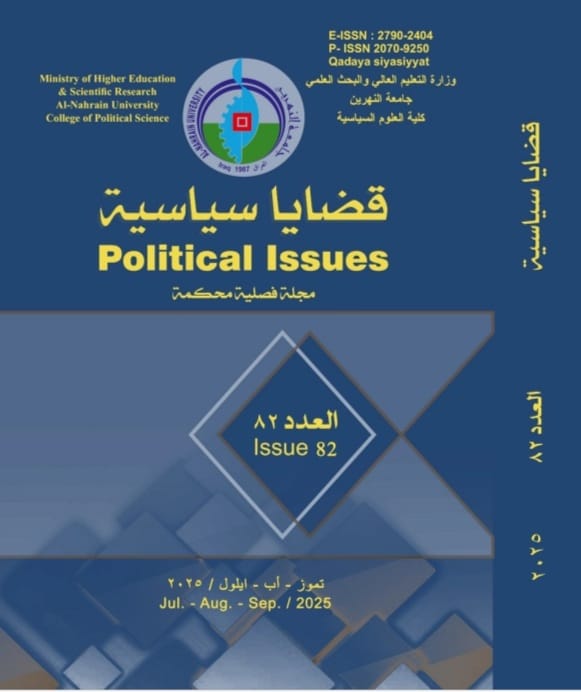Strategic Leadership: Conceptual Significance and Theoretical Patterns
DOI:
https://doi.org/10.58298/822025773Keywords:
Strategic Leadership , Leadership Styles , Strategic Performance, Political Stability , Strategic ManagementAbstract
This study aims to analyze the conceptual foundations and theoretical patterns of strategic leadership as a central element in state management within a turbulent strategic environment. The research adopts a descriptive–analytical approach of an inductive nature, through a review of relevant literature and theories, linked to contemporary developments in leadership patterns. The study examines the distinction between the leader and leadership, the historical roots of strategic leadership, and its modern conceptual evolution, in addition to analyzing the main leadership styles, including transformational, transactional, autocratic, and democratic, and their impact on strategic performance. The findings indicate that effective strategic leadership is based on clarity of vision, institutional flexibility, the capacity for innovation, and the ability to influence human and social capital, as it constitutes an interactive process between leaders and followers that contributes to political stability, sustainable development, and enhances the state’s capacity for strategic adaptability.
References
• Harvey, D. F. Strategic Management and Business Policy. 2nd ed. Columbus, OH: Merill Publishing Co., 1988.
• Joyce, P. Strategic Leadership in the Public Services. London: Routledge, 2012.
• Richard, L., and M. Katherine. Becoming a Strategic Leader: Your Role in Your Organization’s Enduring Success. San Francisco: Jossey-Bass, 2005.
________________________________________
دوريات ومجلات علمية (Journals & Reviews)
• Abdow, A. I. “The Role of Strategic Leaders in Challenging Environment.” European Journal of Business Management 2, no. 1 (2015): 22–35.
• Bass, B. “Executive and Strategic Leadership.” International Journal of Business 12, no. 1 (2007).
• Boal, K. B., and R. Hooijberg. “Strategic Leadership Research: Moving On.” Leadership Quarterly 11, no. 4 (2001): 515–549.
• Bono, J. E., and T. A. Judge. “Personality and Transformational and Transactional Leadership: A Meta-Analysis.” Journal of Applied Psychology 89, no. 5 (2004): 901–910. https://doi.org/10.1037/0021-9010.89.5.901.
• Carter, S. M., and C. R. Greer. “Strategic Leadership: Values, Styles, and Organizational Performance.” Journal of Leadership & Organizational Studies 20, no. 4 (2013): 375–393.
• Colbert, A. E., A. L. Kristof-Brown, B. H. Bradley, and M. R. Barrick. “CEO Transformational Leadership: The Role of Goal Importance Congruence in Top Management Teams.” Academy of Management Journal 51, no. 1 (2008): 81–96.
• Dyczkowska, B. J., and T. Dyczkowski. “Democratic or Autocratic Leadership Style? Participative Management and Its Links to Rewarding Strategies and Job Satisfaction in SMEs.” Athens Journal of Business & Economics 4, no. 2 (2018): 193–218.
• Elenkov, D. S. “Effects of Leadership at Strategic Level and Its Moderators on Innovation: An International Empirical Study.” International Journal of Business Strategy 8, no. 2 (2008): 37–47.
• Erben, G. S., and A. B. Güneşer. “The Relationship between Paternalistic Leadership and Organizational Commitment: Investigating the Role of Climate Regarding Ethics.” Journal of Business Ethics 82, no. 4 (2008): 955–968.
• Fiedler, F. E. “Research on Leadership Selection and Training: One View of the Future.” Administrative Science Quarterly 41, no. 2 (1996): 241–251.
• Hambrick, D. C., and P. A. Mason. “Upper Echelons: The Organization as a Reflection of Its Top Managers.” Academy of Management Review 9, no. 2 (1984): 193–206.
• Hunt, J. G. “Transformational/Charismatic Leadership’s Transformation of the Field: An Historical Essay.” Leadership Quarterly 10, no. 2 (1999): 129–144.
• Hussain, M., and H. Hassan. “The Leadership Styles Dilemma in the Business World.” International Journal of Organizational Leadership 5, no. 4 (2016): 411–425. https://www.aimijournal.com.
• Lord, R. G. “Functional Leadership Behaviour: Measurement and Relation to Social Power and Leadership Perceptions.” Administrative Science Quarterly 22, no. 1 (1977): 114–133.
• Mubarak, M. F., and W. F. W. Yusoff. “Impact of Strategic Leadership on Strategy Implementation.” British Journal of Management and Marketing Studies 2, no. 1 (2019): 32–43.
• Rowe, W. G. “Creating Wealth in Organisations: The Role of Strategic Leadership.” Academy of Management Executive 15, no. 1 (2001): 81–94.
• Schoemaker, P. J. H., S. Krupp, and S. Howland. “Strategic Leadership: The Essential Skills.” Harvard Business Review 91, no. 1–2 (2013): 131–134.
• Vera, D., and M. Crossan. “Strategic Leadership and Organizational Learning.” Academy of Management Review 29, no. 2 (2004): 222–240.
• Wheeler, S., W. McFarland, and A. Kleiner. “A Blueprint for Strategic Leadership.” Strategy and Business 49 (2007): 1–13.
________________________________________
الرسائل والإطريح الجامعية (Theses & Dissertations)
• Lear, L. W. The Relationship between Strategic Leadership and Strategic Alignment in High-Performing Companies in South Africa. Doctoral thesis, University of South Africa, 2012.
• Mpofu, S. Strategic Leadership Challenges in the Management of Projects in the Parastatals. Doctoral thesis, University of the Witwatersrand, Johannesburg, 2010.
• Mwiinga, G. Role of CEO Personality in Strategic Leadership. Master’s thesis, University of Pretoria, 2011.
• Nyabdza, G. W. The Lived Experience of the Strategic Leader: What Effective CEOs Do, How They Do It and an Exploration into How They Think About It. DBL thesis, University of South Africa, Pretoria, 2008.
________________________________________
الفصول في كتب محررة (Book Chapters)
• House, R. J. “A 1976 Theory of Charismatic Leadership.” In Leadership: The Cutting Edge, edited by J. G. Hunt and L. L. Larson, 189–207. Carbondale, IL: Southern Illinois University Press, 1977.
• Sheng, V. G. Y., and G. N. Soutar. “The Role of Ethical Behaviors in the Relations between Leadership Styles and Job Performance.” In ANZMAC 2005 Conference: Corporate Responsibility, 24–33. https://www.researchgate.net/publication/265806307.
Additional Files
Published
Issue
Section
License
Copyright (c) 2025 علي حسين حميد

This work is licensed under a Creative Commons Attribution 4.0 International License.
This is an Open Access article distributed under the terms of the creative commons attribution (CC BY) 4.0 international license which permits unrestricted use, distribution, and reproduction in any medium or format, and to alter, transform, or build upon the material, including for commercial use, providing the original author is credited.






